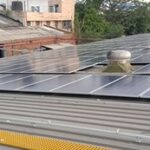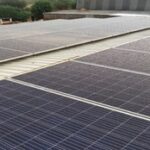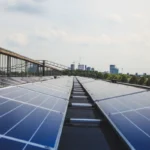How to Calculate Savings from Rooftop Solar Solutions: A Complete Guide
How to Calculate Savings from Rooftop Solar Solutions: A Complete Guide
The Union Cabinet on 17th June, 2015 approved the revised target of 100,000 MW for solar power for 2022. This includes the target of 40,000 MW for solar rooftop projects. The Government also proposes to provide subsidy for rooftop projects. There was a provision for 30% capital subsidy for these projects under the Grid Connected Rooftop & Small Solar Plants Programme of the Ministry of New & Renewable Energy (MNRE), which has recently been reduced to 15% of the total cost or Rs. 12.00 per watt, or Rs. 1.20 crore per MW. It is not clear whether this has come into effect as yet. In any case, there is a huge backlog in clearing pending subsidy payments under the erstwhile scheme.
The solar rooftop projects are increasingly becoming viable on their own on account of very high electricity tariffs in most States, particularly for commercial and industrial consumers, as well as high cost of captive diesel generation, on the one hand, and rapidly declining costs of photovoltaic generation, on the other hand. Therefore, capital subsidy is not really required any more.
In any case, the procedures for applying and claiming the subsidy from the MNRE and the State Nodal Agencies are complex, cumbersome and time-consuming. There are long delays in approval and disbursement on account of budgetary constraints.
Moreover, subsidies are self-limiting and distort markets. There is ample evidence of this from earlier programmes driven by subsidy such as biogas, solar lighting and water heating which could never become truly commercial.
Also, frequent chopping and changing creates confusion among prospective consumers. Announcements about subsidy raise expectations among consumers who then wait to avail subsidy, which does not come or gets severely delayed, thus depriving the market of those that would have otherwise decided on an already viable investment.
Government should instead utilize its funds and regulatory mechanisms to facilitate and support market development and commercialization. Support could be provided towards
- low-cost financing instruments to attract investments
- to the supply chain to produce quality products at lower cost
- for catalyzing new business models for implementation such as RESCOs
- for capacity building of Distribution Companies, banks and other stakeholders
- on awareness creation and public information
- on testing and standardization
- for creation of a skilled manpower pool to meet the gigantic goals
On the hand, the regulatory oversight needs to be tightened to ensure that
- mandatory orders are complied with
- net/gross metering gets implemented
- RPO obligations are met by all entities
- banks to the last branch are aware and abide by Orders of Priority Sector Lending and other instructions on lending to renewable energy projects.
Instead of subsidies, such facilitation and oversight would accelerate market development more effectively through measured and calibrated Government support thus enabling the overall target to be met successfully. This would, of course, require an all-round change of mind set in Government as well as the people.
Suggested Articles

6 Upcoming Renewable Energy Events in India You Should Attend
The World Environment Expo, 2022 is a business platform that allows national and international equipment

500 kW Solar System Price in Haryana: Latest Cost, Benefits & Savings
Looking to install a 500 kW solar system in Haryana? Discover the latest 2025 price range, government incentives, and key benefits for commercial and industrial users. Learn how adopting solar can cut electricity bills and boost long-term savings.

Net Metering and Its Advantages Explained: How Solar Users Save More on Energy Bills
Learn what Net Metering and its advantages mean for you—cut electricity costs, earn energy credits, and boost solar efficiency easily.

Best Solar Panels for Rooftop Projects: How to Choose the Right One
Selecting the right solar panel is crucial for rooftop project success. This guide explains how to evaluate panel types, efficiency, warranties, and performance to ensure maximum power output and long-term savings for your home or business.

Solar Chankya: Complete Guide to Solar Systems and Components
Discover the key components of solar systems—from panels to inverters and batteries—and how they work together for efficient energy solutions

Solar Cell Technology: Monocrystalline vs Polycrystalline vs Thin-Film
Explore the different types of solar cells, including monocrystalline, polycrystalline, and thin-film, and learn their efficiency, applications, and benefits for solar energy systems.

Solar Panel Selection Demystified: How to Choose the Right Panels for Solar Installation
Choosing the right solar panels can be confusing with so many options in the market. This guide simplifies solar panel selection by comparing types, efficiency ratings, and cost factors. Whether for your home, business, or industry, learn how to make an informed decision and maximize the return on your solar investment.

COP27: Harnessing Solar Energy for a Sustainable Future
COP27 is the latest in a long line of global climate conferences, which have been held regularly since 1994. The United Nations Framework Convention on Climate Change (UNFCCC) was created at the 1992 Rio Earth Summit.

6 Innovative Applications of Solar Energy You Should Know About
Explore how solar energy is revolutionizing daily life and industries. From solar-powered transport to smart cities, discover six groundbreaking solar applications shaping a cleaner, smarter future.

How DISCOMs Implement Net Metering for Solar Power Plants
Discover the process of net metering implementation by DISCOMs for solar power plants. Understand the benefits, billing mechanism, and how it maximizes solar energy utilization.